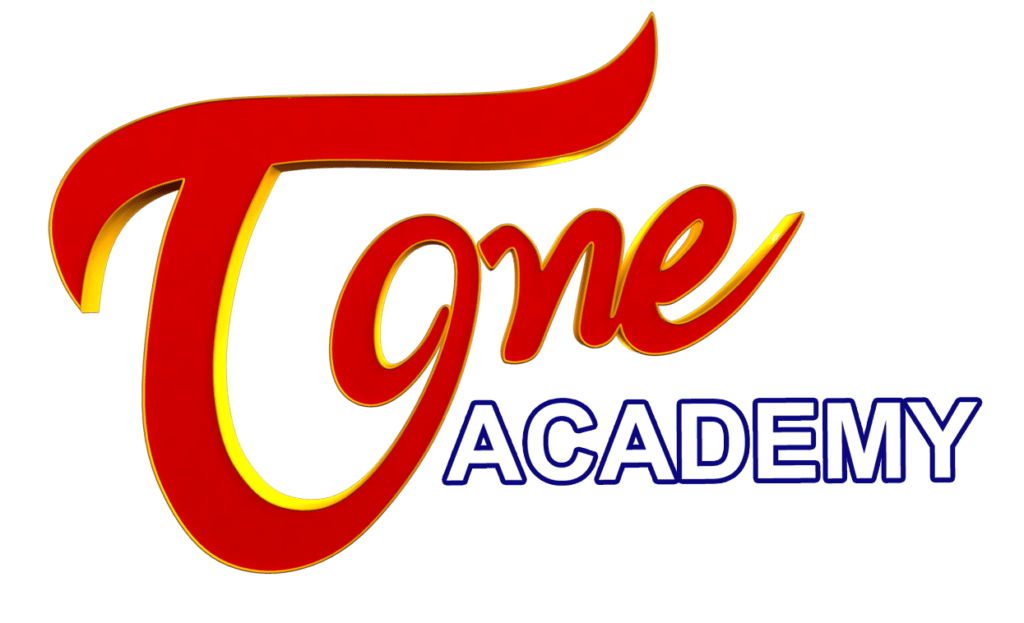NITI Aayog Releases Report on “Enhancing Competitiveness of MSMEs in India
Syllabus:Reports
NITI Aayog, in collaboration with the Institute for Competitiveness (IFC), has released a comprehensive report titled “Enhancing MSMEs Competitiveness in India”. The report offers a roadmap to unlock the potential of India’s Micro, Small and Medium Enterprises (MSMEs) through systemic reforms in financing, skilling, innovation, and market access.
Key Highlights:
- Credit Access: Formal credit access improved between 2020 and 2024 — from 14% to 20% for micro and small enterprises, and from 4% to 9% for medium enterprises. However, a significant credit gap of ₹80 lakh crore persists. The report calls for revamping the Credit Guarantee Fund Trust for Micro and Small Enterprises (CGTMSE) with better institutional collaboration.
- Skill & Innovation Deficit: A large section of MSME workers lack formal technical or vocational training, limiting productivity and scalability. Investment in R&D and innovation remains low, weakening global competitiveness.
- Technology Adoption Challenges: Barriers include unreliable power, weak internet connectivity, and high costs. Many MSMEs are unaware of or unable to access government schemes aimed at technological support.
- Cluster Analysis: Upgrading outdated technologies and strengthening branding and marketing capacities are key to improving competitiveness.
- Policy Gaps: While multiple national and state-level MSME support policies exist, low awareness and weak implementation dilute impact. The report recommends better monitoring, data integration, and stakeholder engagement.
Way Forward:
- The report emphasizes the need for state-level, cluster-based policies, enhanced digital marketing and logistics support, and improved market linkages, particularly in high-growth regions like eastern and northeastern India. Strengthening institutional frameworks and boosting awareness are crucial to driving inclusive and sustainable growth in the MSME sector.
With reference to the recent report titled “Enhancing MSMEs Competitiveness in India”, released by NITI Aayog in collaboration with the Institute for Competitiveness (IFC), consider the following statements:
- The report identifies the textile and chemical sectors among the four primary MSME sectors analyzed for competitiveness.
- The Credit Guarantee Fund Trust for Micro and Small Enterprises (CGTMSE) currently covers more than 80% of the formal credit demand of the MSME sector.
- The report finds that the lack of awareness about state-level schemes is a major constraint in technology adoption by MSMEs.
- The National Skill Qualification Framework (NSQF) was identified as a major success factor for MSME skilling programs across all sectors.
Which of the above statements is/are correct?
A. 1 and 3 only
B. 2 and 4 only
C. 1, 3, and 4 only
D. 1, 2, and 4 only
Answer: A. 1 and 3 only
Explanation:
- Statement 1: Correct. The report focuses on four sectors: textiles and apparel, chemical products, automotive, and food processing.
- Statement 2: Incorrect. The CGTMSE, while expanded, still leaves a large credit gap. Only about 19% of credit demand was met formally as of FY21.
- Statement 3: Correct. The report highlights that lack of awareness and accessibility to state government schemes is a barrier to technology adoption.
- Statement 4: Incorrect. NSQF is not cited in the report as a major driver; instead, the report flags gaps in vocational and technical training.
India and Denmark signs renewed Memorandum of Understanding (MoU) today
Syllabus:IR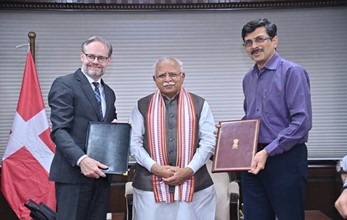
- India and Denmark have deepened their collaboration in the energy sector by signing a renewed Memorandum of Understanding (MoU) aimed at accelerating the clean energy transition and supporting India’s target of achieving net-zero emissions by 2070.
- The MoU was signed by Shri Pankaj Agarwal, Secretary, Ministry of Power, and E. Mr. Rasmus Abildgaard Kristensen, Ambassador of Denmark to India, in the presence of Shri Manohar Lal, Minister of Power and Housing & Urban Affairs. This renewed agreement builds on five years of successful cooperation under the original MoU signed on June 5, 2020, which was set to expire in June 2025.
- The updated agreement expands the scope of partnership to include advanced energy domains such as:
Power system modeling
- Integration of variable renewable energy
- Cross-border electricity trading
Development of electric vehicle (EV) charging infrastructure
- It also strengthens institutional cooperation through expert exchanges, joint training programs, and study tours.
- Minister Manohar Lal emphasized that this renewed cooperation reaffirms the shared vision of India and Denmark to promote sustainable development and green energy solutions through innovation and technological collaboration.
Which of the following statements regarding the India–Denmark energy cooperation MoU (2025) is/are correct?
- It supports India’s commitment to achieve net-zero emissions by 2050.
- The renewed MoU expands cooperation to include power system modeling and EV infrastructure.
- The original MoU was signed in 2020 and was valid for a period of five years.
Select the correct answer using the code below:
- 1 and 2 only
- 2 and 3 only
- 1 and 3 only
- 1, 2 and 3
Answer: B
Explanation:
- India’s net-zero target is by 2070, not 2050.
- The rest are correct. short explanation. India’s net-zero emissions target is set for 2070, not 2050.
- However, the MoU does include cooperation on power system modeling and EV infrastructure, and the original agreement was signed in 2020 for five years, making statements 2 and 3 correct.
GAME and NITI Aayog join hands to catalyse healthy entrepreneurship ecosystems across India
Syllabus:Environment
- NITI Aayog and the Global Alliance for Mass Entrepreneurship (GAME) have joined forces in a strategic partnership aimed at fostering dynamic entrepreneurship ecosystems across multiple Indian states.
- The initiative will begin with pilot projects in Nagpur, Visakhapatnam, and parts of Uttar Pradesh, focusing on place-based interventions tailored to the unique needs of each region.
- The collaboration brings together key local stakeholders — including government agencies, corporates, educational institutions, financial entities, experienced entrepreneurs, and community-based organisations — to support local entrepreneurs through targeted, community-driven approaches.
- The objective is to create self-sustaining ecosystems that promote entrepreneurship as a vehicle for economic growth and job creation.
- Speaking on the partnership, Ishtiyaque Ahmed, Programme Director for Industry/MSME at NITI Aayog, emphasized the need for bottom-up engagement, working closely with grassroots entrepreneurs to understand and address their specific challenges.
- GAME’s proven methodologies will guide the pilot interventions, covering areas such as access to finance, capacity building, policy support, and community mobilization. The broader goal is to build scalable models that can be replicated across India.
- Ketul Acharya, President of GAME, highlighted the organisation’s mission to democratize entrepreneurship: “This collaboration is a major step towards enabling millions to start and grow businesses using local resources, solving local problems, and reaching broader markets.”
- Since its inception in 2018, GAME has supported over 300,000 entrepreneurs through various programs focused on improving access to credit, markets, and regulatory support.
- It has also played a significant role in empowering women entrepreneurs and promoting sustainable business models in underserved regions.
- This new initiative is expected to generate innovative, context-sensitive solutions to the systemic barriers that hinder entrepreneurship in India.
- By leveraging local talent and fostering deep collaboration, NITI Aayog and GAME aim to create vibrant, inclusive, and resilient entrepreneurial ecosystems that can drive long-term economic transformation.
With reference to the partnership between NITI Aayog and the Global Alliance for Mass Entrepreneurship (GAME), consider the following statements:
- The collaboration focuses on top-down policy directives to standardize entrepreneurship promotion across all Indian states.
- Pilot interventions under this partnership will initially be implemented in Nagpur, Visakhapatnam, and parts of Uttar Pradesh.
- GAME was established by the Ministry of Skill Development and Entrepreneurship to promote formal sector employment.
Which of the statements given above is/are correct?
A. 2 only
B. 1 and 3 only
C. 2 and 3 only
D. 1, 2 and 3
Correct Answer: A. 2 only
Explanation:
- Statement 1 is incorrect: The partnership adopts a bottom-up, place-based approach—not a top-down one.
- Statement 2 is correct: Nagpur, Visakhapatnam, and regions in Uttar Pradesh are the initial pilot sites.
- Statement 3 is incorrect: GAME is an independent organisation established in 2018, not by a government ministry.
India and EU reaffirm Commitment to Conclude Ambitious FTA by the End of 2025, Deepen Strategic Trade Ties
Syllabus:IR
- Commitment to Conclude FTA by End of 2025: India and the European Union have reaffirmed their commitment to finalize the FTA by the end of 2025.
- This decision follows discussions between Indian Commerce Minister Piyush Goyal and EU Commissioner for Trade and Economic Security Maroš Šefčovič.
- Strategic Importance of the Agreement: The FTA aims to enhance economic resilience and inclusive growth by addressing global trade challenges and fostering a balanced, fair, and mutually beneficial trade partnership.
- Ongoing Negotiations and Upcoming Rounds: Both parties emphasized the importance of maintaining momentum through regular negotiating rounds, with the next round scheduled for May 12–16, 2025, in New Delhi.
- Focus on Non-Tariff Barriers (NTBs):India highlighted the need to address non-tariff barriers alongside tariff discussions, emphasizing that regulatory frameworks should be inclusive, proportionate, and avoid restricting trade.
- Support for Digital Transition and Resilient Supply Chains:The FTA aspires to support the digital transition and promote diversified and resilient supply chains, reflecting the evolving realities of global commerce.
- Enhanced Investment Flows and People-to-People Mobility:Both sides acknowledged the crucial role of investment flows and people-to-people mobility in sustaining economic vitality, aiming to facilitate these aspects through the agreement.
- Alignment with India’s Vision for 2047:The India-EU FTA is seen as an instrument to promote diversified production networks and uphold fair trade principles, aligning with India’s development goals for 2047.
With reference to the India–European Union Free Trade Agreement (FTA) negotiations held in 2025, consider the following statements:
- The agreement seeks to promote digital transition and the development of resilient supply chains.
- India emphasized the prioritization of tariff reductions over non-tariff barriers (NTBs) in the negotiations.
- The FTA is aligned with India’s long-term development goals for 2047 and its global role as a “Vishwa Mitra”.
- The negotiations are being conducted through bi-annual high-level summits only, with no provision for monthly dialogue.
Which of the statements given above is/are correct?
A. 1 and 3 only
B. 2 and 4 only
C. 1, 2 and 4 only
D. 1, 3 and 4 only
Answer: A. 1 and 3 only
Explanation:
- Statement 1 is correct – The FTA includes provisions to support digital transition and resilient supply chains.
- Statement 2 is incorrect – India emphasized the need to address non-tariff barriers (NTBs), not prioritize tariffs over NTBs.
- Statement 3 is correct – The agreement is aligned with India’s 2047 vision and its aspiration to be a “Vishwa Mitra”.
- Statement 4 is incorrect – Negotiations are ongoing through monthly rounds and virtual engagements, not limited to bi-annual summits.
India’s Total Exports Grow by 6.01% to Reach Record $824.9 Billion in 2024–25, Up from $778.1 Billion in 2023–24:RBI Report
Syllabus:Economy
- India’s total exports surged to an all-time high of US$824.9 billion in FY 2024–25, reflecting a 01% growth over the previous year’s figure of US$778.1 billion, according to the Reserve Bank of India’s latest services trade data (March 2025).
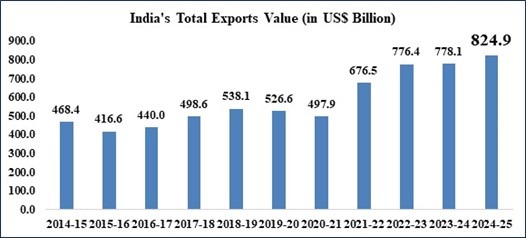
Key Highlights:
- Services Exports:
- Reached a historic high of US$387.5 billion in FY 2024–25.
- Growth of 6% over FY 2023–24 (US$341.1 billion).
- For March 2025 alone: US$35.6 billion, up 6% YoY.
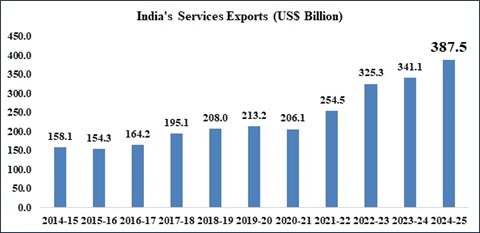
Non-Petroleum Merchandise Exports:
- Touched a record US$374.1 billion, up 0% from US$352.9 billion in FY 2023–24.
- Represents the highest-ever annual non-petroleum merchandise exports.
- This strong performance highlights the robust momentum in services trade and the sustained growth in diversified merchandise exports, marking a new milestone in India’s export-led economic trajectory.
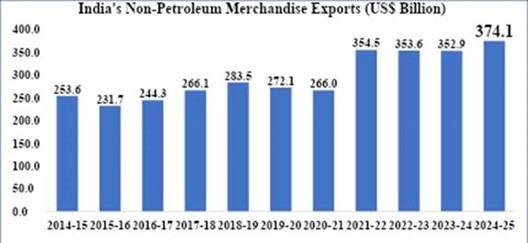
Consider the following statements regarding India’s export performance in FY 2024–25:
- India’s total exports grew by more than 6% over the previous year.
- The growth in services exports outpaced the growth in non-petroleum merchandise exports.
- March 2025 alone contributed over US$40 billion in services exports.
Which of the above statements is/are correct?
A. 1 and 2 only
B. 2 and 3 only
C. 1 only
D. 1, 2, and 3
Answer:A
Explanation:
- Statement 1 is correct (6.01% growth).
- Statement 2 is correct (services grew 13.6%, non-petroleum merchandise grew 6%).
- Statement 3 is incorrect (March 2025 services exports = US$35.6 billion)
India poised to become the capital of MICE tourism’
Syllabus:Governance
- India is on track to become the global hub for MICE (Meetings, Incentives, Conferences, and Exhibitions) tourism, Union Tourism Minister Gajendra Singh Shekhawat said on Friday, while inaugurating a two-day seminar hosted by the Indian Exhibition Industry Association.
- “New avenues in tourism are rapidly emerging, with MICE tourism standing out as the most significant and fastest-growing segment in the country. The development of exhibition and conference infrastructure in cities like Mumbai, Delhi, Hyderabad, Bengaluru, Jaipur, and even smaller cities—especially after the G-20 summit—underscores the vast potential in this sector,” Mr. Shekhawat stated.
- He emphasized the need for close collaboration between the government and the private exhibition industry to fully harness these opportunities.
Consider the following cities mentioned as part of India’s emerging MICE tourism infrastructure:
- Mumbai
- Delhi
- Bengaluru
- Jaipur
- Varanasi
Which of the above are explicitly mentioned in the statement by the Union Minister?
A. 1, 2, 3, and 4 only
B. 1, 2, 4, and 5 only
C. 2, 3, 4, and 5 only
D. All of the above
Answer: A
Explanation:
- Mumbai, Delhi, Bengaluru, and Jaipur were explicitly mentioned by the Union Minister as key cities contributing to the growing MICE tourism infrastructure in India.
- Hyderabad was also mentioned in the statement, but Varanasi was not listed among the cities cited by the Minister. Therefore, Varanasi is the city that was incorrectly included in the options.
ITBP team scales Mt. Makalu, fifth highest peak in the world
Syllabus :Geography

- The Indo-Tibetan Border Police (ITBP) successfully reached the summit of Mt. Makalu, the world’s fifth-highest peak at 8,485 meters above sea level, the force announced on Friday.
- The historic ascent took place on April 19 in Nepal. The International Mountaineering Expedition, which also aimed to summit Mt. Annapurna (8,091 meters), was flagged off from Delhi on March 21.
- “This marked a historic twin summit attempt, a first of its kind in ITBP’s history.
- Both peaks were being attempted by the force for the first time, adding to the significance and legacy of the mission.
- Both mountains are located in Nepal,” stated the ITBP. The 12-member team, led by Deputy Commandant Anoop Kumar Negi with Nihas Suresh as deputy leader, was divided into two groups of six climbers each.
With reference to the recent achievement of the Indo-Tibetan Border Police (ITBP), consider the following statements:
- ITBP successfully scaled Mt. Makalu, the world’s fifth-highest peak.
- The twin summit attempt included Mt. Makalu and Mt. Everest.
- The expedition was led by Deputy Commandant Anoop Kumar Negi.
Which of the above statements is/are correct?
A. 1 and 3 only
B. 1 and 2 only
C. 1 only
D. 1, 2, and 3
Answer:A
Explanation:
- Statement 1 is correct, as ITBP scaled Mt. Makalu, the fifth-highest peak.
- Statement 2 is incorrect. The twin summit attempt included Mt. Makalu and Mt. Annapurna, not Mt. Everest.
- Statement 3 is correct. The expedition was led by Deputy Commandant Anoop Kumar Negi.
Japan expresses full support to India in fight against terror
Syllabus:IR
- During his visit to India, the Speaker of Japan’s House of Representatives, Nukaga Fukushiro, condemned the Pahalgam terror attack and assured India of Japan’s full cooperation in the fight against terrorism.
- He conveyed this message during bilateral talks with Lok Sabha Speaker Om Birla, expressing Japan’s solidarity with India in eradicating terrorism.
- An official statement noted that Mr. Fukushiro assured Mr. Birla of Japan’s unwavering support in the fight against terrorism. He emphasized that terrorism is a global challenge, and all democratic nations must unite to eliminate it.
- Birla highlighted the importance of the India-Japan relationship in the current global context, stating that their friendship is crucial for global peace, prosperity, and stability.
- He mentioned that both countries share common concerns and viewpoints on regional and global issues.
- Additionally, he noted that India and Japan are partners in various multilateral forums, such as the QUAD, G20, and the International Solar Alliance.
- He emphasized that the strong bilateral relationship is grounded in mutual understanding, which is vital for co-beneficial progress and for maintaining peace and stability in the Indo-Pacific region.
With reference to the recent visit of the Speaker of Japan’s House of Representatives, Nukaga Fukushiro, consider the following statements:
- Fukushiro condemned the Pahalgam terror attack and expressed Japan’s full cooperation to India in fighting terrorism.
- The bilateral talks between Mr. Fukushiro and Lok Sabha Speaker Om Birla focused on enhancing economic cooperation between the two countries.
- Both leaders emphasized the importance of global cooperation to fight terrorism and strengthen international security.
Which of the above statements is/are correct?
A. 1 and 3 only
B. 1 only
C. 2 and 3 only
D. 1, 2, and 3
Answer:A
Explanation:
- Statement 1 is correct, as Mr. Fukushiro condemned the Pahalgam attack and offered Japan’s cooperation.
- Statement 2 is incorrect, as the focus was on terrorism, not specifically economic cooperation.
- Statement 3 is correct, as both leaders stressed the global challenge of terrorism and the need for international collaboration.
Caste census to boost opportunities for the needy: Sitharaman
Syllabus:Society
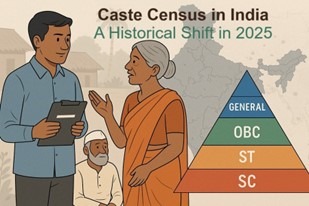
- Union Finance Minister Nirmala Sitharaman clarified on Friday that the Centre’s decision to include caste enumeration in the upcoming Census was not aimed at gaining political advantage, but rather to improve opportunities for the less privileged. She made these remarks during an event organized by the Shankar IAS Academy in Chennai, where newly selected civil service officers were being greeted.
- Sitharaman emphasized that the ruling DMK should not attempt to exploit the Centre’s decision for political gain.
- When asked about the DMK and the INDIA bloc claiming credit for the decision, she pointed out that the DMK should refrain from discussing caste, given its professed commitment to “samathuvam” (equality).
- She explained that the Census data would provide the necessary information to create better opportunities for the underprivileged.
- Sitharaman also referenced the continuing prevalence of caste-based discrimination in Tamil Nadu, noting that caste names still appear on nameboards in some streets.
- She mentioned that, in Tamil Nadu, it was in the name of community that sewage had been mixed with drinking water, an act she claimed had not been witnessed in the northern states that are often considered backward.
- Addressing questions about Tamil Nadu Chief Minister M.K. Stalin’s statements regarding the denial of funds by the Central government, Sitharaman responded by expressing surprise that while DMK leaders privately thanked her for the funds the state had received, they publicly made contradictory statements.
- She said, “We have provided funds under the MGNREGA. They thank me privately, acknowledging the receipt of funds, but publicly, they act as though the state has not received any support.”
With reference to Union Finance Minister Nirmala Sitharaman’s remarks regarding caste enumeration in the upcoming Census, consider the following statements:
- Sitharaman clarified that the inclusion of caste enumeration in the Census is aimed at improving opportunities for the less privileged, not for political gain.
- Sitharaman criticized the DMK for exploiting the Centre’s decision on caste enumeration for political advantage, highlighting their commitment to equality (“samathuvam”).
- She pointed out that caste-based discrimination remains prevalent in Tamil Nadu, citing the continuing practice of caste names on nameboards and the mixing of sewage with drinking water.
- Sitharaman also responded to allegations by Tamil Nadu Chief Minister M.K. Stalin regarding the denial of funds, expressing surprise at the contradictory public and private statements made by the DMK.
Which of the above statements is/are correct?
A. 1, 3, and 4 only
B. 1, 2, and 4 only
C. 1 and 3 only
D. All of the above
Answer:D
Explanation:
- Statement 1 is correct: Sitharaman emphasized that the caste enumeration decision is aimed at creating better opportunities for the less privileged, not for political reasons.
- Statement 2 is correct: She criticized the DMK for trying to gain political advantage from the decision, especially when the party claims to be committed to “samathuvam” (equality).
- Statement 3 is correct: She referenced caste-based discrimination in Tamil Nadu, including the continuing display of caste names on nameboards and the mixing of sewage with drinking water.
- Statement 4 is correct: Sitharaman highlighted the inconsistency between DMK leaders privately acknowledging receipt of funds under MGNREGA and publicly criticizing the Centre for withholding funds.
